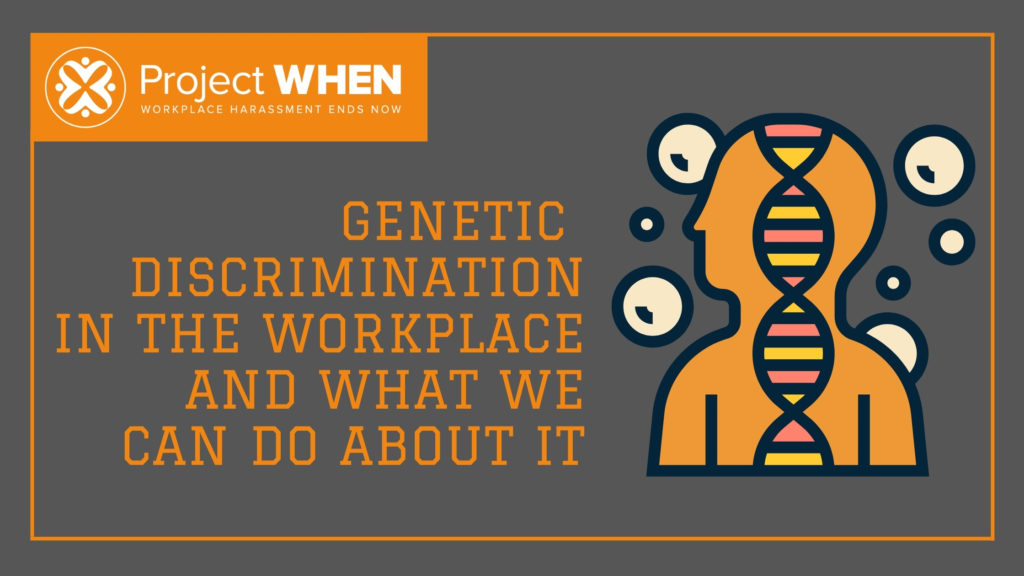Genetic discrimination in the workplace: How companies can prevent it and what employees can do if it happens

Awareness against genetic discrimination
 Are you a victim of genetic information discrimination or have you observed it happening in your workplace? Let’s explore some facts that you should know in order to handle it.
Are you a victim of genetic information discrimination or have you observed it happening in your workplace? Let’s explore some facts that you should know in order to handle it.
Our mission at Project WHEN (Workplace Harassment Ends Now) is to elevate awareness to eliminate harassment and create more respectful workplaces. This post on genetic discrimination is part of our series of pages educating the public about various types of workplace harassment, how employers can prevent it, and employees’ rights under the law.
What is genetic discrimination?
 Genetic discrimination is the act of discriminating against an applicant or an employee on the basis of their genetic information. This includes information about a person’s and his/her family members’ genetic tests, and perceived genetic conditions based on family medical history.
Genetic discrimination is the act of discriminating against an applicant or an employee on the basis of their genetic information. This includes information about a person’s and his/her family members’ genetic tests, and perceived genetic conditions based on family medical history.
In this post, we’ll touch on real examples of genetic discrimination, the laws offering protection from it, and the recourse victims have under the law. Importantly, we’ll also cover what employers can do to prevent it from occurring in the workplace, along with delving into what companies should do to address genetic discrimination claims. You’ll also find a number of resources we feel are helpful for those dealing with this problem.
Examples of genetic discrimination
Proving a genetic discrimination claim can be complicated, but there are distinct examples of conducts that are unlawful. For instance, genetic discrimination may manifest when screening individuals for a job position.
In a lawsuit filed by the Equal Employment Opportunity Commission (EEOC), Dollar General Stores, Inc. was charged with screening out applicants who have medical conditions even if those would not affect their job performance. The company violated the federal law when it required applicants to answer specific questions about their family medical history during medical examinations.
Adverse employment decisions such as firing may also be a manifestation of genetic discrimination. To illustrate, the EEOC challenged a Minneapolis-based company’s conduct of requiring an employee to sign medical release forms to have a fitness for duty examination. According to the suit, the company fired an employee when he refused to sign the required release. The federal agency argued that the employee was being asked irrelevant information. In addition, the medical release form would have forced the employee to disclose his family medical history which is a violation of the federal law.
These are some of the real genetic discrimination cases workers face in workplaces today. There are more manifestations of this type of discrimination which will be covered later in this post and in our recommended resources.
Statistics on genetic discrimination
According to the Equal Employment Opportunity Commission (EEOC), filings of genetic information discrimination reached 209 in fiscal year 2019 which decreased by 5% compared to records in 2018. This data does not include charges filed with state or local Fair Employment Practices Agencies.
Although it is the least reported basis of discrimination with the EEOC, this still shows that this problem still persists today.
Employers may think that their actions do not have serious consequences and victims may not have a clear understanding of protections available to them. Awareness is of utmost importance, first and foremost, in these situations. Read on to explore what laws protect you from it, as well as key actions to take by both companies and victims in dealing with this type of discrimination.
Genetic discrimination laws
Federal law
 The Genetic Information Nondiscrimination Act (GINA) offers protection to individuals in two categories. Title I prohibits health insurers from discriminating against enrollees in health coverage because of their genetic information. Title II protects employees and applicants from genetic discrimination in aspects of employment such as hiring, firing, compensation, promotions, job assignments, layoffs, training, benefits, and other work conditions.
The Genetic Information Nondiscrimination Act (GINA) offers protection to individuals in two categories. Title I prohibits health insurers from discriminating against enrollees in health coverage because of their genetic information. Title II protects employees and applicants from genetic discrimination in aspects of employment such as hiring, firing, compensation, promotions, job assignments, layoffs, training, benefits, and other work conditions.
Harassing people due to their genetic information is also illegal under GINA. Harassment can take the form of insults or offensive remarks about a person’s genetic information as well as those of his/her relatives. For it to be considered as harassment under the law, the act must be severe enough to create a hostile work environment for the victim. This means that one-off teasing or a non-serious isolated incident is not recognized as a harassment case.
Additionally, an employer may not request, require, or purchase an employees’ or applicants’ genetic information during interview, after onboarding, and after commencement of work. For example, it is illegal for an employer to ask if there is any history of sickle cell anemia in your family’s medical records. However, there are a few narrow exceptions to this rule which will be enumerated in the excerpt of the law below.
The legal requirements apply to employers with 15 or more employees. This includes state, local, and federal government agencies; labor organizations; and joint-labor management training and apprenticeship programs.
Below is an excerpt from Title II of the GINA. You can view the full text here.
|
GENETIC INFORMATION NONDISCRIMINATION ACT TITLE II—PROHIBITING EMPLOYMENT DISCRIMINATION ON THE BASIS OF GENETIC INFORMATION SEC. 202. EMPLOYER PRACTICES. (a) DISCRIMINATION BASED ON GENETIC INFORMATION.—It shall be an unlawful employment practice for an employer— (1) to fail or refuse to hire, or to discharge, any employee, or otherwise to discriminate against any employee with respect to the compensation, terms, conditions, or privileges of employment of the employee, because of genetic information with respect to the employee; or (2) to limit, segregate, or classify the employees of the employer in any way that would deprive or tend to deprive any employee of employment opportunities or otherwise adversely affect the status of the employee as an employee, because of genetic information with respect to the employee. (b) Acquisition of Genetic Information.—It shall be an unlawful employment practice for an employer to request, require, or purchase genetic information with respect to an employee or a family member of the employee except– (1) where an employer inadvertently requests or requires family medical history of the employee or family member of the employee; (2) where— (A) health or genetic services are offered by the employer, including such services offered as part of a wellness program; (B) the employee provides prior, knowing, voluntary, and written authorization; (C) only the employee (or family member if the family member is receiving genetic services) and the licensed health care professional or board certified genetic counselor involved in providing such services receive individually identifiable information concerning the results of such services; and (D) any individually identifiable genetic information provided under subparagraph (C) in connection with the services provided under subparagraph (A) is only available for purposes of such services and shall not be disclosed to the employer except in aggregate terms that do not disclose the identity of specific employees; (3) where an employer requests or requires family medical history from the employee to comply with the certification provisions of section 103 of the Family and Medical Leave Act of 1993 (29 U.S.C. 2613) or such requirements under State family and medical leave laws; (4) where an employer purchases documents that are commercially and publicly available (including newspapers, magazines, periodicals, and books, but not including medical databases or court records) that include family medical history; (5) where the information involved is to be used for genetic monitoring of the biological effects of toxic substances in the workplace, but only if— (A) the employer provides written notice of the genetic monitoring to the employee; (B) (i) the employee provides prior, knowing, voluntary, and written authorization; or (ii) the genetic monitoring is required by Federal or State law; (C) the employee is informed of individual monitoring results; (D) the monitoring is in compliance with– (i) any Federal genetic monitoring regulations, including any such regulations that may be promulgated by the Secretary of Labor pursuant to the Occupational Safety and Health Act of 1970 (29 U.S.C. 651 et seq.), the Federal Mine Safety and Health Act of 1977 (30 U.S.C. 801 et seq.), or the Atomic Energy Act of 1954 (42 U.S.C. 2011 et seq.); or (ii) State genetic monitoring regulations, in the case of a State that is implementing genetic monitoring regulations under the authority of the Occupational Safety and Health Act of 1970 (29 U.S.C. 651 et seq.); and (E) the employer, excluding any licensed health care professional or board certified genetic counselor that is involved in the genetic monitoring program, receives the results of the monitoring only in aggregate terms that do not disclose the identity of specific employees; or (6) where the employer conducts DNA analysis for law enforcement purposes as a forensic laboratory or for purposes of human remains identification, and requests or requires genetic information of such employer’s employees, but only to the extent that such genetic information is used for analysis of DNA identification markers for quality control to detect sample contamination. (c) Preservation of Protections.—In the case of information to which any of paragraphs (1) through (6) of subsection (b) applies, such information may not be used in violation of paragraph (1) or (2) of subsection (a) or treated or disclosed in a manner that violates section 206. |
State Law
Many states have laws that protect individuals from genetic discrimination. The best way to learn more about additional protections you can receive locally is to refer to your state’s department of labor website. Our guide on reporting incidents of workplace harassment links to each state’s DOL website, as well as some of the regional and city organizations, for those in more populous areas.
Recourse for victims of genetic discrimination
Victims of genetic information discrimination in the workplace have the right to seek legal recourse. If you have already reported it to your company’s HR and you are not seeing any signs of moving forward, you have the option to consult legal counsel or an employment lawyer. These professionals can help you evaluate the case and provide valuable advice regarding your claims.
A best next step could also be filing a charge either through your state administrative agency or the EEOC, a federal agency that enforces federal laws related to harassment and discrimination in the workplace. Acting promptly is important since victims have 180 days to file a charge with the EEOC while federal employees have 45 days to contact an EEO Counselor.
You are not required to speak with an attorney before approaching a government agency to discuss your situation; these entities are in place to protect your rights as an employee and are typically willing to give guidance on suggested next steps for you as a victim.
To know about the process of reporting genetic discrimination cases, refer to our full guide on How to Report Workplace Harassment Incidents. This article provides a comprehensive list of state resources and local EEOC offices. You can also head directly to the EEOC’s page on How to File a Charge of Employment Discrimination.
What can companies do to prevent genetic discrimination?
Companies have the responsibility to prevent genetic information discrimination from transpiring in the workplace. One significant step to take is to be knowledgeable of the rules stated in the law. With the right combination of properly enforced policies and a holistic examination of business processes and culture, developing a respectful work environment is a possibility for any organization.
The initiative to prevent this type of discrimination must start with senior leadership, but sometimes change takes one individual who has the courage to speak up. If you are passionate about ensuring the safety of employees from the different manifestations of discrimination, consider getting your company involved with Project WHEN (Workplace Harassment Ends Now).
As a first step, we’d ask you to sign our Pledge of Commitment to demonstrate your commitment to creating a respectful, harassment-free workplace for your employees.
For a holistic and structured approach to living out your commitment, we would encourage you to enroll in the WHEN™ Organizational Certification program. In this program, we will guide you through a step-by-step process of preventing all types of workplace harassment. This certification will also serve as a powerful statement to both internal and external audiences about your commitment to making your workplace a safe space for everyone. The Employee Culture Pulse Survey, which is also offered as a standalone service, will be administered to employees in the first phase of this program. The actionable data gained from this survey will allow you to identify challenges in your fight against workplace harassment and strategize your path to improvement.
What should companies do when genetic discrimination happens?
Discrimination based on genetic information can happen even if it’s not the employer’s intention. This can be a result of not having enough guidance or information about one’s responsibilities as an employer. In the event that genetic discrimination happens within the workplace, it is essential for employers to show accountability and take the lead to drive change.
 If you are ready to begin discussions on creating a fair and more respectful work environment, we can facilitate a Project WHEN Roundtable. This event can help attendees identify challenges present in their current working conditions and gain insight on the best action steps to eliminate traces of discrimination in the workplace.
If you are ready to begin discussions on creating a fair and more respectful work environment, we can facilitate a Project WHEN Roundtable. This event can help attendees identify challenges present in their current working conditions and gain insight on the best action steps to eliminate traces of discrimination in the workplace.
If you are a concerned individual who wants to help create or maintain a harmonious workplace, let your employer know about this and ask for a facilitated discussion to take place.
Remember, the problem of genetic information discrimination will not solve itself. It is important for everyone to develop heightened awareness of what they can do to make a difference. Change will only take place if people within the workplace take the initiative to address issues, no matter how uncomfortable it may be.
Additional resources and recommended readings
For more information about genetic information discrimination, we’ve rounded up some resources that you can consult and find below.
- Genetic Information Discrimination | EEOC
- Fact Sheet: Genetic Information Nondiscrimination Act
- Genetic Information – FAQs
- Genetic Information – Example
- Genetic Information Nondiscrimination Act (GINA) | U.S. Department of Labor
End genetic discrimination now
Nobody should have to face genetic discrimination or any form of harassment, for that matter. Project WHEN is a 501(c)(3) nonprofit organization working hard to make workplaces more respectful for everyone. Elevating awareness to prevent workplace harassment from taking place is what runs at the core of our organization.
Whether you’d like to make a financial contribution to support our work, sign the Project WHEN Pledge of Commitment, have your employer host a Project WHEN event, or just join our mailing list to learn of volunteer opportunities, everyone can get involved with Project WHEN!

